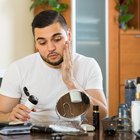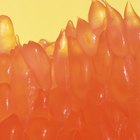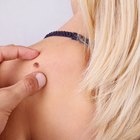
Killing a nail-bed fungus that grows in and under nails in the area referred to as the “nail bed,” can improve the appearance of nails. According to the Palo Alto Medical Foundation, nail-bed fungal infections are a common problem. In most cases, the problem only hurts the nails by causing discoloration and brittle nails, but sometimes the infection can cause pain or other health concerns that make killing the fungus a necessity.
Avoid home remedies for nail-bed fungus. Due to the odd location of the fungus, home remedies do not work. Killing a nail-bed fungus requires medications that have strong anti-fungal ingredients. Home remedies are not strong enough to deal with nail-bed fungus.
See a doctor about the problem as soon as possible. A doctor needs to determine the exact problem. Have the doctor run a test on the nail to avoid mixing up the cause of the problem with another condition. Usually the doctor will take a sample of the nail, such as a nail clipping, and will send it to a lab for various tests for fungal and bacterial infections. Since bacterial infections and fungal infections require different medications, the doctor wants to confirm that the problem is fungal. Most likely, there will be a fungal infection under the nails, but there are other problems that mimic a fungal infection.
Get a prescription for an appropriate anti-fungal medication from the doctor and take it as directed. The most effective medications available are oral medications because these will kill the fungus at the source. Topical medications are usually less effective because they do not reach the nail bed. Many anti-fungal medications for nail-bed fungus will need to be continued for a month or so. Common anti-fungal medications for nail infections include itraconazole, ketoconazole and fluconazole, which are effective against more than one type of fungus.
Make follow-up appointments while on the medications. Typically follow-up appointments should be once every two weeks or so until the medication is stopped. The doctor will check for any spread of the infection, ineffective treatment and will run tests to ensure the medication is having no harmful side effects.
Tell the doctor if the fungus recurs after medication or if there are any side effects that suggest the medication is harming health. Common side effects are usually mild, such as headaches or upset stomach, but liver damage can sometimes occur, especially when drinking alcohol while on this medication. Dizziness, dark urine, fatigue and skin discoloration should be reported to a doctor immediately, as they are signs of liver damage. Also inform the doctor if the medication is not working so she can determine if the cause is something else. Doctors will often require a follow-up appointment at least once after the medication has been completed, usually within a few days, to ensure there are no health problems.
Related Articles

Crumbling Nail Tips

How Do I Get Yellow Stains Out of My ...

Do Nails Grow Faster With or Without ...

How To Use Tazorac To Treat Flat Warts

How to Restore Trust in a Relationship ...

Grapefruit Extract for Eczema

If You Soak Your Nails in Water Will ...

How to Get Lint Out of Your Nails

How to Treat Hematoma & Swelling After ...

How to Reduce Acne Inflammation

Grapefruit Seed Extract for Seborrheic ...

Is Listerine Effective in Treating ...

Subungual Warts and Treatment

How to Kill Hair Follicles

Tea Tree Oil Cure for Halitosis

A Wart on the Shoulder

How to Treat Acne Caused by Provera

How to Prepare for Laser Bikini Hair ...

What Prescriptions Can Get Rid of Under ...

Garlic for Psoriasis
References
Writer Bio
Helen Jain has been writing online articles since December 2009 for various websites. She has studied English and psychology and hopes to get a Ph.D. in English in the future.
Photo Credits
toes image by Sandra Henderson from Fotolia.com